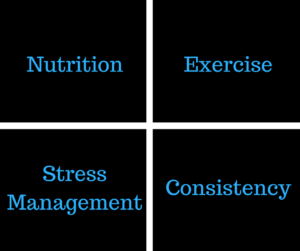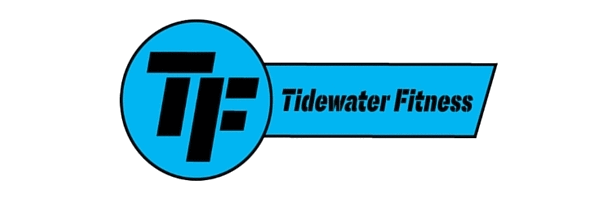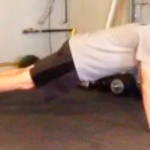Most people today complain about being too busy. And it’s understandable. Between work, family, and your social life I’m sure it’s hard to imagine fitting anything else onto your plate.
But if you have a goal you want to accomplish, the fact of the matter is, you have to put in the work. This is especially true when it comes to getting fit.
Many people think they have to change their entire lifestyle in order to change the way their body looks and feels. The truth is, you can get fit even when you’re super busy.
And I’ll show you exactly how.
When it comes to improving your fitness, there are 4 big pillars you need to know about. Here they are.

Without checking off each of these boxes, the chances of you getting into great shape decrease dramatically. Now, this article is meant for for those who don’t have a lot of time to spare. So the good news is, each of these tips are very easy to integrate into your life.
Let’s look at these a little more in depth and how we can get them to fit into your hectic schedule.
1. Nutrition: Intermittent fasting
Intermittent fasting is surging in popularity these days. And for good reason. Research has shown that fasting can reduce bodyweight and body fat (1). This is why it has become a go-to for those looking to lean out quickly.
The reason it’s great for the busy person, is it’s simplicity. There are many different types of fasting out there, but the one that I’m going to reference is the 16/8 method.
In this method, you fast for 16 hours and eat during an 8 hour window. Following this approach, you would eat 2-3 times during an 8 hour time period like 1 pm-9 pm.
The beauty of this method of fasting is it takes breakfast off the table, literally. Most of us are rushing out the door anyway in the morning, so why not take something else off your to-do list.
This allows you to put your focus into 2 meals per day, lunch and dinner. And focusing on 2 meals per day versus 3 is a lot easier to manage. The reason fasting works so well is two-fold.
- Insulin is decreased: If you eat constantly throughout the day, insulin is increased and remains elevated. Insulin is a hormone that promotes fat storage. During the fasting periods, insulin is lowered and your body can burn fat.
- Calories are decreased: Because you’re eating one less meal, you won’t be eating as much food each day. Lower calories means lower weight and body fat.
With each meal, you still need to focus on consuming real foods. Each meal should include 1-2 palm size servings of protein like meat or fish, 1-2 fist sized portions of vegetables, 1-2 cupped hands worth of carbohydrates, and 1-2 thumb sized servings of fat. Check this out if you want more info.
2. Exercise: Density circuits
When you’re short on time the last you need is an exercise program that requires you to spend hours upon hours in the gym each week. This is where density circuits come in handy.
Density circuit training is a training method based around doing a pre-determined set of exercises (usually between 4-6) as many times as possible in a specific amount of time (I like to do these between typically 10-20 minutes). There is no set rest, so you rest only as needed.
The goal each week you do a circuit is to perform more rounds than you did in the previous week.
This is a perfect way to get in a total body workout in a short amount of time. Here is a sample template you can use to build a program:
- Lower body exercise
- Upper body pull exercise
- Upper body push exercise
- Ab exercise
So an example would look like this:
- Reverse Lunge x 8/s
- Inverted Row x 10
- Push Up x 8
- Stability Ball Rollout x 8
If you wanted to really wanted to up the ante, you could add a cardio exercise at the end. So your template would look like this:
- Lower body exercise
- Upper body pull exercise
- Upper body push exercise
- Ab exercise
- Cardio exercise
And a sample program would look like this:
- Reverse Lunge x 8/s
- Inverted Row x 10
- Push Up x 8
- Stability Ball Rollout x 8
- Treadmill sprint x 30 seconds
Either way, you would do the circuit as many times as possible in 10-20 minutes. For this example, we’ll say you did 15 minutes.
Now let’s say you get 4 total rounds the first time you do it. Next time, you could shoot to get in 5 rounds on the reverse lunge and 4 rounds on everything else. This would beat your previous number of rounds. And that’s the goal when it comes to density circuits: try to get a little bit better each week.
3. Stress Management: Sleep
Stress is one of the biggest progress killers. When you’re stressed, as most of us are when extremely busy, cortisol is elevated.
Chronic elevation of cortisol makes primary use of sugar to meet the body’s energy demands, instead of fat. Meaning, you’re not able to burn fat sufficiently. Not only that, but it can also break down muscle tissue. Less muscle means less calories burned throughout the day.
The best way to combat stress is sleep. The average American gets 6.8 hours of sleep on average. This isn’t good. Most research shows that 7-9 hours is appropriate for an adult.
Sleep offers a ton of benefits other than just stress reduction. It will help you feel energized the next day, reduce your food cravings, and is even linked with weight loss. If you aren’t getting in 7-9 hours of sleep per night, here are a couple of things that will help:
- Set a bed time: I know it sounds like a childish thing to do, but most people live by a schedule. Setting a specific time to go to bed, will ensure you shut off what you are doing and actually go to bed. Be sure this time is 7-9 hours from when you’re scheduled to wake up.
- Turn off lights and electronics 1 hour before bed: You need melatonin to be released to help you sleep better. Lights and electronics disrupt melatonin secretion making it harder to fall asleep. This is one of the main reasons why it’s important to keep your room as dark as possible when you sleep.
Do these two things and they will massively improve your sleep quality.
4. Consistency
This one is fairly straightforward. If you want to accomplish a goal, you will only do so if you’re consistently doing something to reach that goal. Simple as that.
Inconsistency is something most of us struggle with. We want things here and now. In this day and age, you can order something online and have it arrive at your house in a couple of days. In some cities, it’s a couple of hours. That instant gratification can actually be a stumbling block when it comes to getting fit.
It’s the main reason why so many people fail to achieve their New Year’s resolutions. They’re motivated for a couple of weeks, but when they don’t see results as quickly as they’d like, they stop altogether. The truth is, this will get you nowhere and leave you frustrated more than anything else.
Getting fit isn’t easy. If it were, everyone would do it. It takes dedication, focus, and persistence to go after what you want. If you’ve had some trouble being consistent here are a couple of things that will help:
- Set a realistic goal with a deadline: Deadlines will motivate you unlike anything else. But the important part of this advice is setting realistic goals. Losing 100 pounds in 3 months isn’t attainable. Creating goals like this will set you up for failure. Figure out something tangible you want to achieve and mark it on your calendar.
- Remember why your is important to you: When getting fit, there will be hard days and easy days. When things get hard, having a WHY behind your goal can be huge. It helps you realize you set your goal for a specific reason. Maybe it was to be a good example for your kids or feel more confident at the beach on your summer vacation. Whatever the reason, doing this will help you stay on track.
- Think positively: Negativity is all around us. And when you’re constantly thinking there’s no way you’ll ever accomplish your goal, then you won’t. A negative mindset shapes a negative reality. Be positive. Forgive yourself if you don’t eat perfectly one week or skip one of your workouts. Put it out of your mind and aim to do better next week.
Wrapping Up
If you’re busy, odds are, you need less stuff in your life. So if you want to get fit, don’t go hunting for the latest diet or exercise trend. These things never work.
Realize that it comes down to following these 4 steps. The journey won’t be easy. But these four strategies should provide clarity as to how you can finally improve your health and fitness, all while juggling a busy schedule.
References:
1. Heilbronn, L.K., et. al. Alternate-day fasting in nonobese subjects: effects on body weight, body composition, and energy metabolism. Am J Clin Nutr. 2005 Jan;81(1):69-73.






